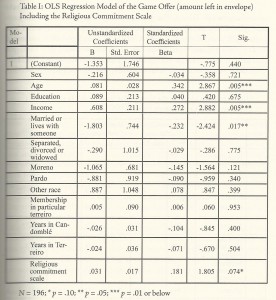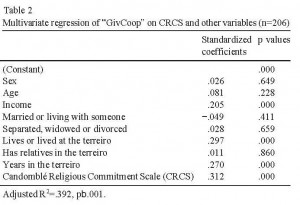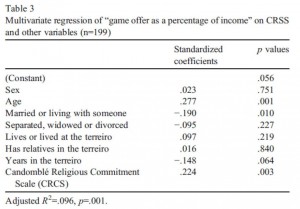I was critiqued in a recent NSF grant proposal review that, while I elegantly integrated signaling & cultural consensus theories in my research design, my statements that (1) signaling theory derives from evolutionary biology & (2) that no one has tested religious signaling in context are dead wrong & overly reliant on the Rich Sosis school of religious signaling. Whoops, guilty as charged. I did know that signaling theory derives equally from economics & a whole bunch of other fields & probably had it footnoted in some previous version that I cut to save space. I learned signaling theory under Lee Cronk in the one brief month I studied at Rutgers before moving to a different graduate program & forgot about it more or less for 5 years until I was writing my dissertation & read Sosis’s “badges, bans, & behaviors” paper, which blew my mind. Since I had just spent two years in Apostolic Pentecostal churches, I could envision everything he was talking about, & it transformed by consciousness about the field site. It was all I could do to stay the course & get my dissertation written without reanalyzing everything from a signaling perspective. Since then, I’ve had a little more time to catch up on this theory & have a paper out in Ethos that discusses an incident my one of my New York field sites from a signaling theory perspective. But, honestly, I haven’t done much more to expand my knowledge of the theory than to read some Bulbulia, Cronk, Sosis & Alcorta, & one really awesome 2005 Bird-Bliege & Smith paper in Current Anthropology (I wish that reviewer had offered a little more direction in this regard, but I guess I will have to actually do my homework myself & Google it–whoops, did I say that out loud?).
However, what I actually consider shameful is that I wasn’t aware at the time of anyone having investigated religious signals of commitment in context, when in fact it has been done by another Cronk student, Montserrat Soler. My friend Bria Dunham, another Cronk-trained signaling theorist, who was assigned as my student-mentor for that brief month at Rutgers, buttonholed me at the last HBES meeting to let me know that I needed to meet her friend Montserrat, who was doing research very similar to mine. Really? No shit? In fact, that book that’s been sitting on your desk for 6 months to review for a course & that actually came out FIVE YEARS AGO, well before you got your dissertation, has a chapter in it by Monterserrat detailing her study of signaling theory among Candomble practitioners in Brazil. (In all fairness to myself, an apocryphal story holds that Charles Darwin had an uncut copy of Mendel’s paper in his library, which was found after he died (but it seems that this is an unconfirmed rumor), by which I suggest not that I am Darwin-like in my intellect but that many of us probably have the answers to most of our intellectual questions at hand in our cluttered offices in books & papers we have yet to read or have forgotten.)
Montserrat outlines her study in “Commitment Costs and Cooperation: Evidence from Candomble, an Afro-Brazilian Religion,” in Bulbulia et al.’s edited volume The Evolution of Religion: Studies, Theories, & Critiques & a more recent piece–“Costly Signaling, Ritual, & Cooperation: Evidence from Candomble, an Afro-Caribbean Religion”–in Evolution & Human Behavior. In the 2008 chapter, she outlines her method of studying religious commitment among Candomble practitioners using a religious commitment scale she devised for the project & an economic game. Candomble is an Afro-Brazilian possession-oriented religion, not unlike Vodou, Santeria, Umbanda, & several others found through the Afro-Caribbean region (& in Afro-Caribbean & Brazilian communities elsewhere). It is “a pragmatic religion primarily concerned with solving the tribulation of everyday life” (Soler 2008:168). Instead of churches, members belong to terreiros, which are the private residences & ritual centers of terreiro leaders. Communication with spirits through possession takes place through rituals, many of which involve elaborate feasts, specific proscriptions regarding behavior, & can last for extended periods of time (months). The investment & cooperation necessary to pull off such rituals provides a natural setting for a study of religious commitment.
She measured commitment among participants of 13 different terreiros that varied in location, size, & age. The scale included 14 statements (with two sub-scales for group & personal commitment), such as “I have never missed a feast at my terreiro” (group commitment) or “there are certain foods I do not eat because of my orixa [main possessing spirit]” (personal commitment) with which participants ranked their agreement. The economic game was designed so that the group benefited if individuals cooperated, but individuals did even better if they did not. The details of this game are a bit fuzzy, but if I understand it correctly, each person participating was anonymously assigned to a 4-person group & given $10. They could keep the $10 or secretly donate any amount to the group, which would then be matched by the researcher & divided evenly among the group. So, potentially, an individual participant could get $35 max if s/he donates nothing but the others in the group donate everything, get $5 min if s/he donates everything but no one else does, or anything in between.

Soler’s regression analysis showing the influence of religious commitment, age, income, & relationship status on religious cooperation (Soler 2008)
Her interesting findings reported in the 2008 chapter were that income was inversely related to the religious commitment scale. This is interesting because it suggests that poorer people give more of themselves to the terreiro. However, this is probably driven by necessity–lacking other structural resources, poorer people invest more because they need more help (which was affirmed thru partial correlation analysis in the 2012 follow-up summarized below). There was no significant correlation between the amount of money an individual donated to the group & the scale, though a positive correlation approached significance when income is controlled for. Regression analysis suggested that the most influential factors on group cooperation (amount donated) were age (older people were more generous), income (people who were older were probably better off–why not remove one of these to get rid of confounding effects on each other…see below), being married or shacked up, & religious commitment. Regression for each subscale revealed the religious commitment effect to be due to group commitment alone.

Regression on self-reported actual cooperation (Soler 2012) showing a significant influence of religious commitment
Her 2012 article provides more detail as to her methodology & analysis of data not previously included in her modeling. For instance, an additional variable for cooperation is based on items querying actual cooperation within one’s terreiro (e.g., “have you ever lent money to someone in your terreiro?”). Regression on this variable indicated significant positive influences of the religious commitment scale, income, having lived in the terreiro, & number of years living there. Thus, claims of commitment were positively associated with actual cooperation. Not only was income a significant influence in the previous analysis, it turns out there was a lot of variation in income, such that the economic game put a lot of money in some people’s pocket & was rather insignificant for others. To control for this, Soler reanalyzed the influence of religious commitment on the amount donated in the economic game but calculated that amount as a percentage of the person’s income. This resulted in a model that approached significance (models in the 2008 analyses did not) AND a significant influence of religious commitment on the amount donated. Finally, religious commitment was not solely related to need or some internal spiritual goodness but also predicted by having received help in the past, which she found by comparing a variable for receiving cooperation (an index of items such as “has someone from your terreiro ever lent you money”?).

Regression on amount donated in economic game as a percentage of income, showing significant influence of religious commitment
It should be noted that she also substituted the mean of completed responses on her religious commitment scale for participants for missing answers among participants who skipped answering only one item. This would have altered the scores for 21 participants, &, since she does not mention whether it made a difference, I’m guessing it did. A final note is a discrepancy between calling her scale the Candomble Religious Signaling Scale (CRSS) & the Candomble Religious Commitment Scale (CRCS). She uses CRSS in the text & CRCS in the tables. I suspect CRCS is a vestige of previous thinking not caught during editing or thru the review (6 reviewers missed this?!) & editorial process because she goes to pains to justify qualifying her scale as an indication of signaling commitment to others & not solely an internal sense of commitment–i.e., she did not include items related to religious salience (importance of belief in everyday decisions) that are generally included in religiosity measures because belief is not observable by others.
Soler’s contribution represents a really elegant & ethnographically sound test of the religious signaling model of commitment that I will have to chew on more as I go forward with a similar study in Costa Rica & Tuscaloosa & consider reanalysis of data I collected for my dissertation research in New York.

Sweet! You’ll have to come back & teach me what I got wrong.
Interesting article! I wonder how many times people end up studying what someone else in another time, place, or discipline has already studied thoroughly. Thanks for teaching us about signaling in HBERG! I am actually hanging out with Eric Smith from The Bird-Smith paper you cited in my lab right now working on costly signaling among hunter gatherers.